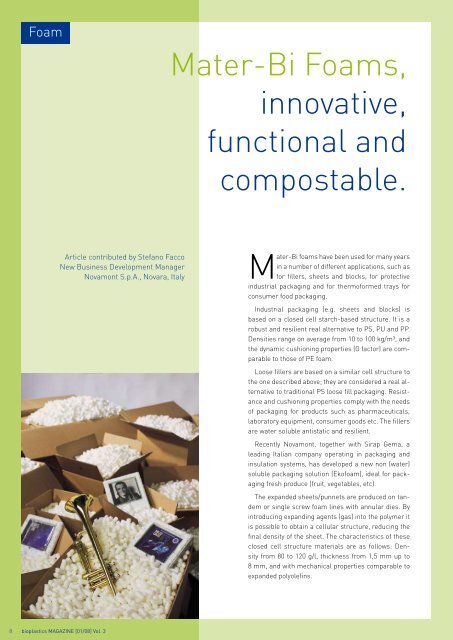01 | 2008
You also want an ePaper? Increase the reach of your titles
YUMPU automatically turns print PDFs into web optimized ePapers that Google loves.
Foam<br />
Mater-Bi Foams,<br />
innovative,<br />
functional and<br />
compostable.<br />
Article contributed by Stefano Facco<br />
New Business Development Manager<br />
Novamont S.p.A., Novara, Italy<br />
Mater-Bi foams have been used for many years<br />
in a number of different applications, such as<br />
for fillers, sheets and blocks, for protective<br />
industrial packaging and for thermoformed trays for<br />
consumer food packaging.<br />
Industrial packaging (e.g. sheets and blocks) is<br />
based on a closed cell starch-based structure. It is a<br />
robust and resilient real alternative to PS, PU and PP.<br />
Densities range on average from 10 to 100 kg/m³, and<br />
the dynamic cushioning properties (G factor) are comparable<br />
to those of PE foam.<br />
Loose fillers are based on a similar cell structure to<br />
the one described above; they are considered a real alternative<br />
to traditional PS loose fill packaging. Resistance<br />
and cushioning properties comply with the needs<br />
of packaging for products such as pharmaceuticals,<br />
laboratory equipment, consumer goods etc. The fillers<br />
are water soluble antistatic and resilient.<br />
Recently Novamont, together with Sirap Gema, a<br />
leading Italian company operating in packaging and<br />
insulation systems, has developed a new non (water)<br />
soluble packaging solution (Ekofoam), ideal for packaging<br />
fresh produce (fruit, vegetables, etc).<br />
The expanded sheets/punnets are produced on tandem<br />
or single screw foam lines with annular dies. By<br />
introducing expanding agents (gas) into the polymer it<br />
is possible to obtain a cellular structure, reducing the<br />
final density of the sheet. The characteristics of these<br />
closed cell structure materials are as follows: Density<br />
from 80 to 120 g/l, thickness from 1,5 mm up to<br />
8 mm, and with mechanical properties comparable to<br />
expanded polyolefins.<br />
bioplastics MAGAZINE [<strong>01</strong>/08] Vol. 3


















